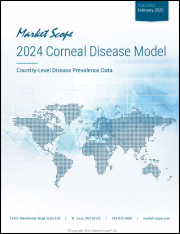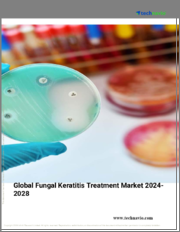
|
시장보고서
상품코드
1374784
세계의 지속성 상피결손 치료 시장(2023-2030년)Global Persistent Epithelial Defect Treatment Market -2023-2030 |
||||||
개요
세계 지속성 상피결손 치료 시장은 수년 동안 여러 가지 요인으로 인해 큰 성장과 변화를 겪어왔습니다. 지속성 상피결손(PED 또는 PCED)은 각막 손상 후 10-14일 이내에 재상피화 및 폐쇄가 이루어지지 않는 경우, 일상적인 지지요법을 사용해도 각막 손상 후 10-14일 이내에 재상피화 및 폐쇄가 이루어지지 않는 경우 발생합니다.
이러한 사례는 드물지만, 지지요법에 저항하는 경우가 많기 때문에 관리상의 어려움이 있습니다. 감염, 각막 흉터, 시력 저하, 용해, 경우에 따라서는 천공과 같은 잠재적 인 부작용을 예방하기 위해 지속성 상피 이상은 신속하고 신중한 치료가 필요합니다.
특히 신흥 경제국의 정부 투자와 연구 개발은 신경 영양 각막염에 대한 첨단 기술 사용을 지속적으로 촉진하여 세계 지속성 상피 이상 치료제 시장을 견인할 것으로 보입니다.
시장 역학: 시장 촉진요인과 시장 억제요인
공동연구 및 라이센스 계약 증가
신흥 경제 국가들은 높은 투자, 소득 수준, 인프라 구축에 힘입어 헬스케어 분야가 빠르게 성장하고 있습니다. 일부 국가에서는 연구 증가로 인해 지속형 상피세포 결손 치료에 대한 수요가 크게 증가하고 있습니다. 다양한 국가 간 공동 연구, 인수, 기술 발전에 따른 라이선스 계약은 시장 성장을 촉진하는 중요한 요인입니다.
2023년 7월 19일, 산텐제약 주식회사(본사: 도쿄도 치요다구, 대표이사 사장: 고바야시 켄, 이하 '산텐제약')는 미국의 2개 회사와 자산 양도 및 라이선스 계약을 체결하였습니다. 산텐제약과 Visiox Pharmaceuticals, Inc.는 OMLONTI의 생산, 마케팅, 판매에 관한 권리에 대한 라이선스 계약을 체결하였습니다. 이번 계약으로 삼천리제약은 Natacyn(결막염, 진균성 안검염, 각막염 점안제), Flarex, ZERVIATE, TobraDex ST, FRESHKOTE를 Harrow Health에 판매 및 양도하고, Harrow Health에 미국 및 캐나다에서의 독점적 제조 및 판매권을 부여합니다. 판매권을 부여합니다.
또한 2023년 4월 28일, 캘리포니아 재생의학연구소(CIRM)는 Kala의 전액 출자회사인 콤방지오(Combangio, Inc.)에 진행 중인 지속성 각막상피결손증(PCED) 치료 프로그램 KPI-012에 대한 자금 지원을 위해 미화 1,500만 달러의 보조금을 수여했습니다. 지원했습니다. 칼라 파마슈티컬스는 희귀하고 심각한 안과 질환에 대한 혁신적인 치료법을 발견, 개발 및 시장 개척에 힘쓰고 있는 임상 단계의 바이오 제약회사다.
또한, 치료 목적으로 새로운 약물과 솔루션의 사용이 증가하고 있습니다. 지속적인 상피 결손 치료 시장의 성장을 촉진하는 주요 요인은 혁신적인 제품 개발을 위한 연구와 함께 상피 결손의 증가와 외과 수술의 증가입니다.
인공눈물이나 무균 안연고에 따른 합병증
치료에 대한 전통적인 의학적 접근법은 방부제가 없는 인공눈물이나 무균 안연고를 사용하여 강제 윤활을 하는 것으로 시작합니다. 이들은 상피가 전형적인 구조와 기능을 회복할 수 있는 상황을 제공합니다. 상피의 재형성을 방해하거나 지연시킬 수 있는 약물의 병용은 모두 중단해야 합니다.
박테리아와 곰팡이 오염을 방지하기 위해 많은 시판되는 인공눈물에는 방부제가 포함되어 있으며, 가장 흔한 방부제는 벤잘코늄 염화물입니다. 이 방부제는 눈에 따끔거릴 뿐만 아니라, 지속적으로 사용하면 눈의 상피를 손상시키고 안구 독성을 유발하는 것으로 나타났습니다.
목차
제1장 조사 방법과 조사 범위
제2장 정의와 개요
제3장 주요 요약
제4장 시장 역학
- 영향요인
- 성장 촉진요인
- 공동 연구나 라이선스 계약 증가
- 기술적 진보와 개발 상승
- 성장 억제요인
- 인공눈물이나 무균 눈연고에 따른 합병증
- 기회
- 영향 분석
- 성장 촉진요인
제5장 산업 분석
- Porter's Five Forces 분석
- 공급망 분석
- 가격 분석
- 규제 분석
- SWOT 분석
- 특허 분석
- 러시아·우크라이나 전쟁의 영향 분석
- DMI 의견
제6장 COVID-19 분석
제7장 질환 유형별
- 사지 줄기세포 결핍
- 신경영양성 각막염
- 염증성 질환
- 상피 접착 부전
- 기타
제8장 치료제별
- 점안제
- 유전자 재조합 인간 NGF 점안액
- 혈청 유래 점안액
- 줄기세포 치료
- 양막 이식
제9장 최종사용자별
- 병원
- 외래 수술 센터
- 전문 클리닉
제10장 지역별
- 북미
- 미국
- 캐나다
- 멕시코
- 유럽
- 독일
- 영국
- 프랑스
- 이탈리아
- 스페인
- 기타 유럽
- 남미
- 브라질
- 아르헨티나
- 기타 남미
- 아시아태평양
- 중국
- 인도
- 일본
- 호주
- 기타 아시아태평양
- 중동 및 아프리카
제11장 경쟁 상황
- 경쟁 시나리오
- 시장 상황/점유율 분석
- M&A 분석
제12장 기업 개요
- Dompe
- 기업 개요
- 제품 포트폴리오와 설명
- 재무 개요
- 주요 발전
- Santen Pharmaceutical Co., Ltd.
- Noveome Biotherapeutics, Inc.
- Recordati Rare Diseases
- Kala Pharmaceuticals
- Corza Ophthalmology
- Amber Ophthalmics
- Kiora Pharmaceuticals, Inc.
- MimeTech Srl
- Cordlife
제13장 부록
ksm 23.11.16Overview
The global persistent epithelial defect treatment market has witnessed significant growth and transformations over the years, with various factors influencing its dynamics. The failure of fast re-epithelialization and closure between 10-14 days of a corneal injury, even when using routine supportive therapy, results in persistent epithelial defects (PEDs or PCEDs).
Although they are uncommon, they present a management challenge since they frequently resist supportive care. To prevent potential side effects like infection, corneal scarring, vision loss, melting, and possibly perforation, persistent epithelial abnormalities require immediate and watchful treatment.
Government investments and research, particularly in developing economies, will continue to drive utilization of advanced technology for neurotrophic keratitis and boost the global persistent epithelial defect treatment market.
Market Dynamics: Drivers & Restraints
Growing collaborations and license agreements
Developed economies have been witnessing rapid growth in betterment of their healthcare sectors, driven by high investments, income levels, and infrastructure development. Several countries have experienced substantial demand for persistent epithelial defect treatment owing to the rising research. Various collaborations, acquisitions and license agreement with technological advancements among different countries will be a crucial factor driving the growth of the market.
On July 19, 2023, Santen Pharmaceutical Co., Ltd. Had executed asset transfer and license agreements with two American businesses. Santen and Visiox Pharmaceuticals, Inc. have reached an out-licensing agreement regarding the rights to OMLONTI's production, marketing, and sales. In accordance with the terms of the contract, Santen is going to sell and transfer Natacyn (an eyedrop for conjunctivitis, fungal blepharitis, and keratitis), Flarex, ZERVIATE, TobraDex ST, and FRESHKOTE to Harrow Health while granting Harrow Health exclusive rights for the product's production and commercialization in the United States and Canada.
Additionally, on April 28, 2023, the California Institute for Regenerative Medicine (CIRM) granted Combangio, Inc., Kala's entirely owned subsidiary, a $15 million grant to help fund its in progress KPI-012 program to treat cases of persistent corneal epithelial defect (PCED). Kala Pharmaceuticals, Inc. is a biopharmaceutical company in the clinical stage dedicated to the discovery, development, and marketing of innovative treatments for rare and severe diseases of the eye.
Furthermore, the rising utilization of novel medicines and solutions for treatment purposes. Rising epithelial defects and increasing surgical procedures along with research for innovative product development will be a major factor driving the growth of the Persistent Epithelial Defect Treatment market.
Complications associated with the artificial tears or sterile ocular ointments
The conventional medical approach for therapy starts with forceful lubrication using artificial tears without preservatives and sterile eye ointments. They give the epithelium a context in which it can recover its typical structure and function. All concurrent drugs that can obstruct or postpone re-epithelialization must be stopped.
To guard against bacterial and fungal contamination, many commercialized artificial tears include preservatives, most frequently benzalkonium chloride. These preservatives have been shown to sting the eyes as well as if used regularly, can harm the eye's epithelium and induce ocular toxicity.
Segment Analysis
The global persistent epithelial defect treatment market is segmented based on disease type, treatment, end user and region.
Ophthalmic solutions treatment segment accounted for approximately 67% of market share
The use of eye drops made from serum to treat PED is growing in popularity. In addition to lubricating the ocular surface, tears contain high concentrations of growth factors and cytokines that are typically found in natural tears, such as vitamin E, vitamin A, EGF, PDGF, TGF-, FGF, substance P, fibronectin, IGF, or NGF. These factors help epithelial cells proliferate and migrate.
NGF has emerged as the model protein for the group of proteins known as neurotrophins, which are involved in the growth and protection of neurons. Following secretion, the proenzyme, pro-NGF, is latent until it is activated by cleavage, at which point it can connect to cell-surface receptors. Numerous studies have indicated the promise of NGF as a treatment for many ocular surface diseases.
On January 9, 2023, positive topline outcomes from the second phase of the double-masked, randomized, vehicle-controlled clinical study (EXPEDE) assessing two topically administered amounts of NEXAGON (lufepirsen ophthalmic gel) for the management of persistent corneal epithelial defect (PCED), supplementary to chemical and/or therapy, were released by the privately owned biopharmaceutical company in clinical-stage, Amber Ophthalmics, Inc.
Geographical Penetration
North America accounted for around 38% of market share in 2022
Due to the rising need for persistent epithelial defect treatment in healthcare, manufacturers in North America have chances of increasing their operations. There are many producers and suppliers in North America and owing to the quick economic growth of the region, industrial production has expanded, driving the demand for persistent epithelial defect treatment.
Increasing expenditure on healthcare, advancement of technologies and different types of products for treatment, along with increase in biopharmaceutical or biotechnology business establishment across the region are also contributing to the growth of persistent epithelial defect treatment market share of this region. The market in this area is growing as people become more aware of various novel innovative systems. The aforementioned elements attest to North America's hegemonic position in the world.
North America continues to be a key player in the global persistent epithelial defect treatment market, with United States leading the way. Government initiatives promoting infrastructure development and investment, and a focus on rising advancements have fueled the demand for persistent epithelial defect treatment in the United States have been proactive in executing several initiatives or surgical procedures, stimulating persistent epithelial defect medications demand.
COVID-19 Impact Analysis
The outbreak of the COVID-19 pandemic in late 2019 created unprecedented challenges for industries worldwide, including the global persistent epithelial defect treatment market. As countries grappled with lockdowns, supply chain disruptions and reduced economic activity, the pharmaceutical sector, with a significant consumer of various treatments, was significantly impacted. The widespread lockdowns and restrictions imposed by the pandemic, which began in early 2020, had an effect on a number of initiatives all around the world.
Major medical and biotechnology industries came to a standstill and shifted their attention towards the management of COVID-19, leading to a slump in demand for persistent epithelial defect treatment. Now several research studies have been initiated and companies have again started trial for their products efficiency. Overall, the impact of the pandemic on the global persistent epithelial defect treatment market is expected to be relatively moderate, with the market continuing to grow steadily due to the ongoing need and research for innovative products, like ophthalmic solutions.
Key Developments
- On April 12, 2023, the U.S. Food and Drug Administration (FDA) has awarded Fast Track designation for KPI-012, human mesenchymal stem cell secretome (MSC-S) therapy by Kala for the management of persistent corneal epithelial defect (PCED), an uncommon and crippling ocular condition. Kala Pharmaceuticals, Inc., a biopharmaceutical company in the clinical stage, committed to the discovery, development, and marketing of novel therapies for rare and serious conditions of the eye.
- On January 3, 2023, the safety and effectiveness of RGN-259 eyedrops in a clinical study in phase 3 in patients having Neurotrophic Keratopathy (NK) are described in a new scientific publication released by RegeneRx Biopharmaceuticals, Inc., a clinical-stage drug manufacturer with a focus on tissue repair, protection, and regeneration. ReGenTree, LLC, a United States-based joint venture between HLB Therapeutics and RegeneRx Biopharmaceuticals, is developing the product candidate. The effectiveness and safety of RGN-259 in accelerating the recovery of persistent epithelial defects among patients having Stage 2 and Stage 3 NK were determined by the study.
- On July 18, 2022, a worldwide ophthalmology contract research company (CRO) and HLB Therapeutics (HLBT), the U.S. joint venture (JV) partner and licensee of RegeneRx Biopharmaceuticals, Inc., a clinical-stage drug development company specializing in tissue repair, protection, and regeneration, have signed an agreement of intent to execute two phase 3 clinical trials concurrently for patients having neurotrophic keratitis (NK) starting in the U.S. and Europe.
Competitive Landscape
The major global players in the market include: Dompe, Santen Pharmaceutical Co., Ltd., Noveome Biotherapeutics, Inc., Recordati Rare Diseases, Kala Pharmaceuticals, Corza Ophthalmology, Amber Ophthalmics, Kiora Pharmaceuticals, Inc., MimeTech Srl and Cordlife.
Why Purchase the Report?
- To visualize the global persistent epithelial defect treatment market segmentation based on disease type, treatment, end user and region as well as understand key commercial assets and players.
- Identify commercial opportunities by analyzing trends and co-development.
- Excel data sheet with numerous data points of persistent epithelial defect treatment market-level with all segments.
- PDF report consists of a comprehensive analysis after exhaustive qualitative interviews and an in-depth study.
- Product mapping available as excel consisting of key products of all the major players.
The global persistent epithelial defect treatment market report would provide approximately 61 tables, 59 figures and 186 Pages.
Target Audience 2023
- Manufacturers/ Buyers
- Industry Investors/Investment Bankers
- Research Professionals
- Emerging Companies
Table of Contents
1. Methodology and Scope
- 1.1. Research Methodology
- 1.2. Research Objective and Scope of the Report
2. Definition and Overview
3. Executive Summary
- 3.1. Snippet by Disease Type
- 3.2. Snippet by Treatment
- 3.3. Snippet by End User
- 3.4. Snippet by Region
4. Dynamics
- 4.1. Impacting Factors
- 4.1.1. Drivers
- 4.1.1.1. Growing collaborations and license agreements
- 4.1.1.2. Rising technological advancements and developments
- 4.1.2. Restraints
- 4.1.2.1. Complications associated with the artificial tears or sterile ocular ointments
- 4.1.3. Opportunity
- 4.1.4. Impact Analysis
- 4.1.1. Drivers
5. Industry Analysis
- 5.1. Porter's Five Force Analysis
- 5.2. Supply Chain Analysis
- 5.3. Pricing Analysis
- 5.4. Regulatory Analysis
- 5.5. SWOT Analysis
- 5.6. Patent Analysis
- 5.7. Russia-Ukraine War Impact Analysis
- 5.8. DMI Opinion
6. COVID-19 Analysis
- 6.1. Analysis of COVID-19
- 6.1.1. Scenario Before COVID
- 6.1.2. Scenario During COVID
- 6.1.3. Scenario Post COVID
- 6.2. Pricing Dynamics Amid COVID-19
- 6.3. Demand-Supply Spectrum
- 6.4. Government Initiatives Related to the Market During Pandemic
- 6.5. Manufacturers Strategic Initiatives
- 6.6. Conclusion
7. By Disease Type
- 7.1. Introduction
- 7.1.1. Market Size Analysis and Y-o-Y Growth Analysis (%), By Disease Type
- 7.1.2. Market Attractiveness Index, By Disease Type
- 7.2. Limbal Stem Cell Deficiency*
- 7.2.1. Introduction
- 7.2.2. Market Size Analysis and Y-o-Y Growth Analysis (%)
- 7.3. Neurotrophic Keratitis
- 7.4. Inflammatory Disease
- 7.5. Defective Epithelial Adhesion
- 7.6. Others
8. By Treatment
- 8.1. Introduction
- 8.1.1. Market Size Analysis and Y-o-Y Growth Analysis (%), By Treatment
- 8.1.2. Market Attractiveness Index, By Treatment
- 8.2. Ophthalmic Solution*
- 8.2.1. Introduction
- 8.2.2. Market Size Analysis and Y-o-Y Growth Analysis (%)
- 8.2.3. Recombinant Human NGF Eye Drops
- 8.2.4. Serum-Derived Eye Drops
- 8.3. Stem Cell Therapy
- 8.4. Amniotic Membrane Transplant
9. By End User
- 9.1. Introduction
- 9.1.1. Market Size Analysis and Y-o-Y Growth Analysis (%), By End User
- 9.1.2. Market Attractiveness Index, By End User
- 9.2. Hospitals*
- 9.2.1. Introduction
- 9.2.2. Market Size Analysis and Y-o-Y Growth Analysis (%)
- 9.3. Ambulatory Surgical Centers
- 9.4. Specialty Clinics
10. By Region
- 10.1. Introduction
- 10.1.1. Market Size Analysis and Y-o-Y Growth Analysis (%), By Region
- 10.1.2. Market Attractiveness Index, By Region
- 10.2. North America
- 10.2.1. Introduction
- 10.2.2. Key Region-Specific Dynamics
- 10.2.3. Market Size Analysis and Y-o-Y Growth Analysis (%), By Disease Type
- 10.2.4. Market Size Analysis and Y-o-Y Growth Analysis (%), By Treatment
- 10.2.5. Market Size Analysis and Y-o-Y Growth Analysis (%), By End User
- 10.2.6. Market Size Analysis and Y-o-Y Growth Analysis (%), By Country
- 10.2.6.1. U.S.
- 10.2.6.2. Canada
- 10.2.6.3. Mexico
- 10.3. Europe
- 10.3.1. Introduction
- 10.3.2. Key Region-Specific Dynamics
- 10.3.3. Market Size Analysis and Y-o-Y Growth Analysis (%), By Disease Type
- 10.3.4. Market Size Analysis and Y-o-Y Growth Analysis (%), By Treatment
- 10.3.5. Market Size Analysis and Y-o-Y Growth Analysis (%), By End User
- 10.3.6. Market Size Analysis and Y-o-Y Growth Analysis (%), By Country
- 10.3.6.1. Germany
- 10.3.6.2. UK
- 10.3.6.3. France
- 10.3.6.4. Italy
- 10.3.6.5. Spain
- 10.3.6.6. Rest of Europe
- 10.4. South America
- 10.4.1. Introduction
- 10.4.2. Key Region-Specific Dynamics
- 10.4.3. Market Size Analysis and Y-o-Y Growth Analysis (%), By Disease Type
- 10.4.4. Market Size Analysis and Y-o-Y Growth Analysis (%), By Treatment
- 10.4.5. Market Size Analysis and Y-o-Y Growth Analysis (%), By End User
- 10.4.6. Market Size Analysis and Y-o-Y Growth Analysis (%), By Country
- 10.4.6.1. Brazil
- 10.4.6.2. Argentina
- 10.4.6.3. Rest of South America
- 10.5. Asia-Pacific
- 10.5.1. Introduction
- 10.5.2. Key Region-Specific Dynamics
- 10.5.3. Market Size Analysis and Y-o-Y Growth Analysis (%), By Disease Type
- 10.5.4. Market Size Analysis and Y-o-Y Growth Analysis (%), By Treatment
- 10.5.5. Market Size Analysis and Y-o-Y Growth Analysis (%), By End User
- 10.5.6. Market Size Analysis and Y-o-Y Growth Analysis (%), By Country
- 10.5.6.1. China
- 10.5.6.2. India
- 10.5.6.3. Japan
- 10.5.6.4. Australia
- 10.5.6.5. Rest of Asia-Pacific
- 10.6. Middle East and Africa
- 10.6.1. Introduction
- 10.6.2. Key Region-Specific Dynamics
- 10.6.3. Market Size Analysis and Y-o-Y Growth Analysis (%), By Disease Type
- 10.6.4. Market Size Analysis and Y-o-Y Growth Analysis (%), By Treatment
- 10.6.5. Market Size Analysis and Y-o-Y Growth Analysis (%), By End User
11. Competitive Landscape
- 11.1. Competitive Scenario
- 11.2. Market Positioning/Share Analysis
- 11.3. Mergers and Acquisitions Analysis
12. Company Profiles
- 12.1. Dompe*
- 12.1.1. Company Overview
- 12.1.2. Product Portfolio and Description
- 12.1.3. Financial Overview
- 12.1.4. Key Developments
- 12.2. Santen Pharmaceutical Co., Ltd.
- 12.3. Noveome Biotherapeutics, Inc.
- 12.4. Recordati Rare Diseases
- 12.5. Kala Pharmaceuticals
- 12.6. Corza Ophthalmology
- 12.7. Amber Ophthalmics
- 12.8. Kiora Pharmaceuticals, Inc.
- 12.9. MimeTech Srl
- 12.10. Cordlife
LIST NOT EXHAUSTIVE
13. Appendix
- 13.1. About Us and Services
- 13.2. Contact Us

















